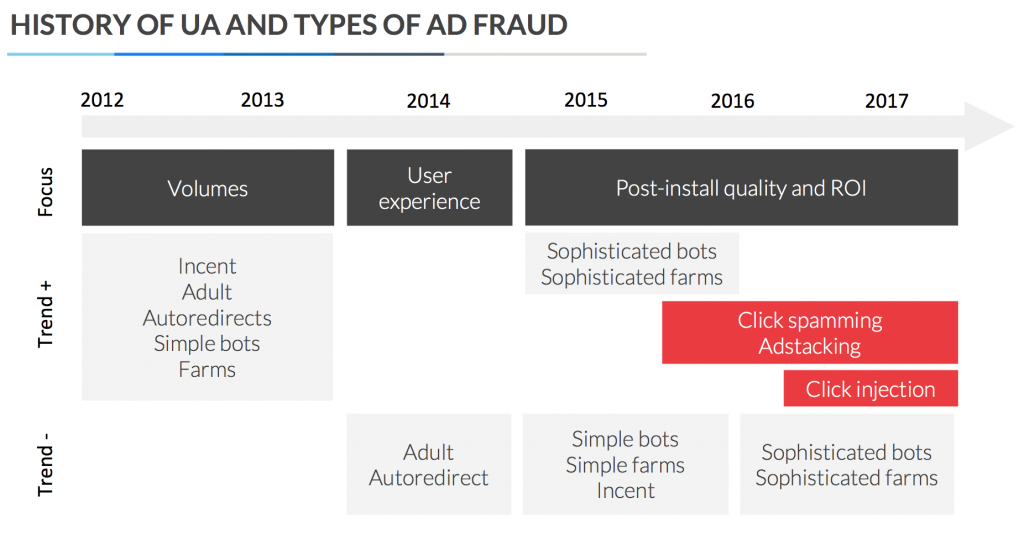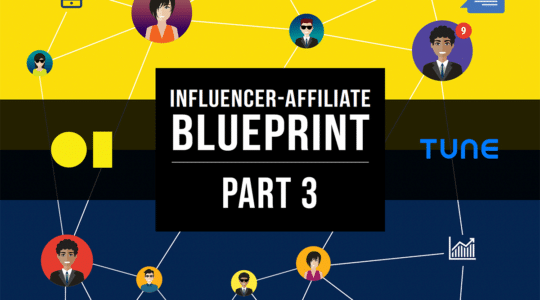
What would your company be able to focus on if you didn’t have to spend time dealing with fraud? Would you build better relationships with clients, focus on creating better products, or perhaps more happy hours with coworkers?
No matter what your role in mobile marketing, fraud is not something that can be escaped. A lucrative business, fraudsters have been coming up with ways to scam marketers, agencies, ad and attribution partners for years. But there is hope — Clément Névoret, director of business operations at AppLift, offers his viewpoint on how fraud affects ad networks, a potential solution, and the impact it could have on our industry.
Fraud Over the Years
Clément has been at AppLift for the past four years, and according to him, fraud has always been a pressing issue. In the mobile marketing industry, fraudsters have always found new ways to grow and survive by delivering what marketers were looking for without being identified. It started back in 2012. At that time, marketers were focused on volume. Fraudsters found ways to deliver volumes.They began buying cheap, unauthorized traffic, generating auto-redirects or developed bots, and install farms.
Then in mid-2013, the focus shifted. Users gave feedback that they were having poor mobile and app experiences, like being redirected to the app store without their consent. Marketers listened and took stronger actions against rampant adult banner ads and the redirect issue.
Post-install quality and and ROI became the metrics to watch in 2015. No longer did marketers just want users to download their apps and click on ads — they wanted users who would engage, stay engaged, and spend money. For every dollar that marketers invested in their ads, they wanted to know exactly what it was being spent on. This shift resulted in less mass installs and more action-based payouts. The methods previously used by fraudsters to only generate volumes became less relevant and led fraudsters to invent new techniques, mimicking post-install user behavior or even steal organic installs. Click farms were replaced with click injection, click spamming, and ad stacking.
Here’s a visualization from Clément of how fraud has trended:

The Impact of Fraud
Fraud is tricky, and never fully easy to identify. It generates big workloads for ad networks and marketers who must investigate the cause, agree on terms once it’s found, and figure out next steps in their partnership. If fraud was found with a specific publisher, should marketers continue working with them, or was it a one-time issue that would be resolved with one phone call? Once fraud comes in the picture, trust between marketers and the ad networks and publishers they work with comes into question.
With fraudsters becoming more and more savvy, the longer it takes to investigate complex cases of fraud. There’s a fine line between suspicious-looking data and fraud, and those who want to fight fraud deal with operational challenges, implementing (costly) tools and teams to do so.
Lastly is the financial impact of fraud. Paying for false installs or fake traffic means lost money for advertisers. If this happens, ad networks lose their relationship and business with advertisers. In the worst cases, legal costs of fighting fraud can come up.
Why Fraud Happens
A big problem like this has many people working on it. A lot of publishers, ad networks, and marketers are all working toward the goal of clean installs. However, there are still issues. Clément states, “Even though at an individual level we are taking initiatives against fraud, at the moment, as an industry, unfortunately, we are fighting fraud very poorly. I think at the moment we are more treating the symptoms rather than the causes of fraud. What’s important is to ask ourselves not what fraud looks like, but more what are fraudsters exploiting?”
According to Clément, what fraudsters are exploiting is conflict of interest and gaps in knowledge at all levels in the industry. At the marketer level, the harsh reality is that it is still common that marketers have insufficient knowledge paired with unrealistic targets. For instance, a user acquisition manager is tasked with hitting 100k installs per month. She is confident she can hit 80k with great ROI and legitimate users, but that last 20k is a struggle. Her job is on the line and her monthly bonus depends on hitting the target — she doesn’t want to underperform. This is a situation where a marketer might turn a blind eye and accept the suspicious or fraudulent traffic, if it means hitting an install target.
At the attribution level, said Clément, specifically for organic theft, attribution partners benefit from a situation where they are perceived as non-responsible for fraud, avoiding responsibility when organic installs get attributed to a paid channel. There is also a lack of consistency between tracking methods between different attribution partners or marketing channels, making it difficult to follow standards and encourages opportunistic behaviors. If Platform A tracks 1,000 installs in a day for a campaign, and Platform B tracks only 300, there is a discrepancy — is one platform better than the other, or is Platform A letting fraudulent traffic go through? This difference in traffic brings up a conversation between the marketer and their tracking platforms and could lead to tensions in the relationship.
How to Deal With Ad Fraud
Fraudsters will keep coming up with creative ways to cheat the system, but there are still ways marketers, ad networks, and publishers can fight together and win the war against fraud.
Advertisers: Level up your knowledge about fraud, and make sure you have appropriate volume/performance expectations are when working with ad networks and publishers. Involving C-level executives to align incentives will give cause to identify fraud and not turn a blind eye to it. Encourage conversations with your attribution companies to address fraud with you.
Attribution companies: Work with marketers and ad networks to fight fraud. Move toward standardizing tracking across all supply sources. (HasOffers has fraud integrations for that.) Provide clients with different ways to identify and combat fraud.
Networks: Work to get more transparency from publishers about their traffic. Build relationships with your publishers so that when issues come up, they are talked about as an ongoing conversation, not on a one-off.
Publishers: Take action to clean up your traffic. Reciprocate building relationships with ad networks.
A Final Word
There are many marketers, ad networks, and publishers working toward the common good of clean installs. This will be an evolving conversation, and requires everyone in the mobile marketing industry to get on board and collaborate. Want to be part of the discussion? Let us know what you think in the comments below.
Author
Becky is the Senior Content Marketing Manager at TUNE. Before TUNE, she handled content strategy and marketing communications at several tech startups in the Bay Area. Becky received her bachelor's degree in English from Wake Forest University. After a decade in San Francisco and Seattle, she has returned home to Charleston, SC, where you can find her strolling through Hampton Park with her pup and enjoying the simple things in life.



Leave a Reply
You must be logged in to post a comment.